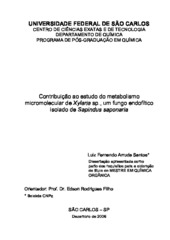Contribuição ao estudo do metabolismo micromolecular de Xylaria sp., um fungo endofítico isolado de Sapindus saponaria
Abstract
This work reports the study of a surprising plant microorganism relationship, involving the plant Sapindus saponaria, which is rich in antigungal saponins, and an endophyte fungus isolated from the pericarpe of the fruits collected in the host plant, and identified as Xylaria sp. The main objective of this work was to understand the survival mechanism of this fungus in such inhospitable ambient. It was found that this fungus biotransforms the structure of the saponins present in S. saponaria, making it less toxic, allowing the fungus to survive in the plant tissue. The reaction involved in this survival mechanism was a hidroxilation at ring C of the aglicone skeleton of saponins present in S. saponaria. This study also had as objective the stablishment of a fast method for the isolation and identification of saponins and ASOG (Acyclic Sesquiterpene Oligoglycosides) present in the plant s fruits. For the isolation of these compounds, the Sephadex® LH-20 column showed to be very efficient and the mass spectrometry technique (ESI-MS) was used as a rapid method of identification of this substances. The Xylaria sp. fungus was cultivated in synthetic mediums for the isolation of secondary metabolites. The microorganism showed a great potential for the production of several compounds, especially the isocoumarins. The analytical tools used to monitor all the experiments reported here comprises chromatographic and spectrometric techniques as HPLC, GC, open column chromatography, MS and MS/MS, 1D NMR and 2D NMR. Mechanisms of fragmentation were tentativelly suggested for all compounds studied by mass spectrometry.
